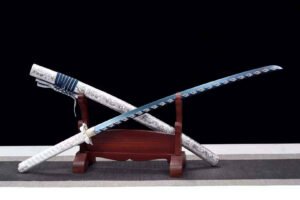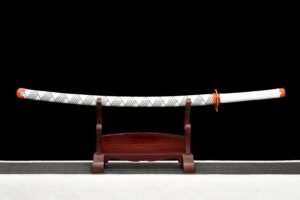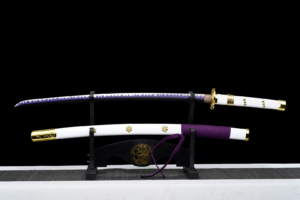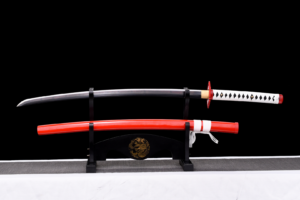The field of collection goes beyond paintings and relics, this one being katana and sabres for lovers of Japanese culture. You are one of them? Would you like to know more about the katana and redecorate your collection? Don’t worry, we provide you with information not only to enable you to make an optimal choice.
Understanding the dimensions of a katana
The katana is one of the Japanese swords that stands out for its curved blade and has a single cutting edge. It should be noted that the length of this blade is traditionally measured in a unit known as the shaku. These are used in Japan and its equivalence is about 30.3 centimeters.

In ancient times, there were three categories of katana according to the length of the blade. So here they are:
- Tantō: blade of less than 1 shaku (less than 30.3 cm).
- Shōtō: blade between 1 and 2 shaku (30.3 cm to 60.6 cm), including wakizashi and kodachi.
- Daitō: blade of more than 2 shaku (more than 60.6 cm), category to which katana belongs.
In addition, it happens that only the length of the blade of the katana is considered. It also extends to the handle (tsuba) which can measure about 30 cm or even more. For a more balanced range, the guard (tsuba) can measure about 6 cm in diameter.
Also the sheath (saya), slightly longer than the blade for adequate protection. In general, a typical katana has a total length of about 100 cm. This length gives it an optimal balance between maneuverability and range for the practitioner.
Length of historical and modern katanas
The katanas have not kept the same length for a long time. In fact, the length of katanas has evolved over the centuries to meet the needs of each and especially according to the time.
During the Nanbokuchō period (14th century), Japanese katana swords had a longer blade. Each blade can reach 91 cm until today. Lengths were chosen to facilitate certain types of combat and technique.
It should be noted that during the Edo period (17th to 19th century), Japan experienced an era of relative peace under the Tokugawa shogunate. This peace and stability under the shogunate led to a decrease in the use of katanas. Because there were fewer battles to be fought and therefore their role became more symbolic and cultural. Under the shogunate, blades were often shorter, and could be around 78 cm.

Also, this size reduction reflected the changing needs and preferences of samurai at that time who fought less on the battlefield.
Finally, martial arts enthusiasts and collectors seem bigger than historical samurai. Note that their average size varied between 155 and 165 cm.
This difference in stature sometimes gives the impression that the Japanese katana sabre is a weapon that can be wielded with one hand or one and a half hands. Despite this impression, the katana is made to be handled with two hands.
Choosing the right katana
The selection of a suitable katana is essential for effective and safe practice of Japanese martial arts such as Iaido. The length of the blade, or nagasa, must be proportional to the size of the user to ensure optimal manoeuvrability. Traditionally, the length of the katana is measured in shaku, a Japanese unit equivalent to about 30.3 cm. For example, a standard katana of “ni-shaku san-sun” corresponds to a blade of about 70 cm.
There are several methods to determine the ideal blade length. The standing katana method is to hold the sword at your side; the tip of the saya should be slightly above the ankle.
Another approach recommends a blade length corresponding to the distance between the ground and your navel. These techniques aim to harmonize the sword with your morphology, thus improving control and stability during movements.
In the practice of iaido, where the skill of drawing and cutting in a single movement is paramount, an appropriate blade length is crucial. A blade that is too long or too short can hinder the flow of techniques and compromise safety. It is therefore recommended that you consult an experienced instructor or specialist dealer to choose a katana suitable for your height and level of practice.
Japanese swords: A brief overview
Japanese swords, emblems of Japanese culture, are distinguished by their curved single-edged blades and their guards, often circular or square. Among them, the katana is particularly famous.
Wielded with two hands, it was the samurai’s weapon of choice on the battlefield, appreciated for its ability to cut with precision. Beyond the katana, there are a variety of other Japanese swords, each with specific characteristics adapted to particular uses.
The length of the blade, or “nagasa”, plays a crucial role in the design of these swords. It influences not only the total length of the weapon, but also its balance, handling and effectiveness in combat.
A well-proportioned blade ensures better performance in martial arts, facilitating cutting techniques and smooth movements. Thus, the precise design and dimensions of each sword reflect an ancestral know-how, combining aesthetics, functionality and historical symbolism.
How to recognize an authentic sword?
Identifying an authentic katana requires careful attention to the specific details of its manufacture and appearance. Some key considerations include:
- Forging materials and techniques
A true katana is traditionally forged from tamahagane, a steel obtained from ferrous sand. The process of bending and hammering steel removes impurities and creates a blade that is both hard and flexible.
- Hamon (quenching line)
This visible line on the blade edge results from the differential quenching process. An authentic hamon has distinct and natural patterns that are difficult to reproduce artificially.
- Mei (blacksmith’s signature)
The silk of the blade (nakago) often bears an engraved inscription, called mei, indicating the name of the craftsman and sometimes the date of manufacture. This signature is a valuable indicator of the authenticity of the sword.
- Koshirae (mount)
Items such as the tsuba (guard), the tsuka (handle) and the saya (sheath) must be made with quality materials and have a careful finish, reflecting traditional Japanese craftsmanship.
- Certificates of authenticity
Some authentic katanas are accompanied by certificates issued by recognized organizations, attesting to their artistic value and quality of manufacture.

How do I know if a seller is reliable?
When buying a genuine katana, it is crucial to ensure the reliability of the seller to avoid counterfeits and unpleasant surprises. Here are some tips for assessing a seller’s credibility:
- Look for feedback from other buyers. Positive testimonials and high ratings are often indicators of confidence.
- Focus on vendors specializing in traditional Japanese weapons. Their specific expertise is a guarantee of quality and authenticity.
- A reliable seller must be able to provide certificates of authenticity and detailed information on the origin of the katana. These documents attest to the craftsmanship and history of the weapon.
- A trusted seller will provide accurate descriptions, detailed photos and will be willing to answer any questions you may have about the katana.
- Check if the seller offers a clear return policy and guarantees on its products, demonstrating their commitment to customer satisfaction.






